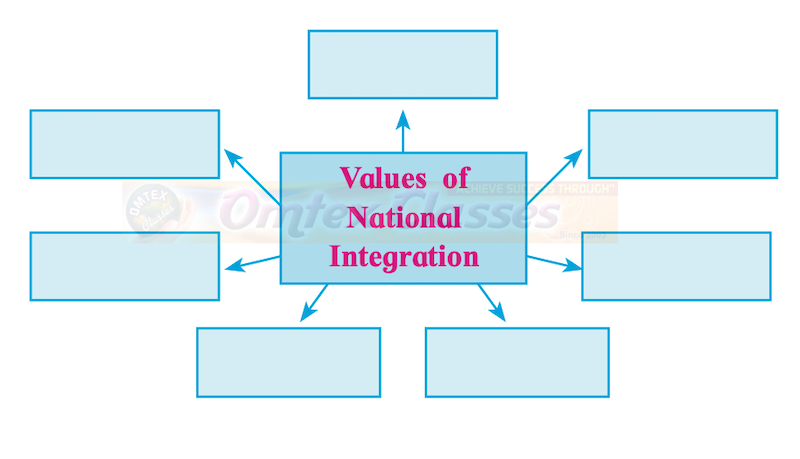Chapter 4: Contemporary India: Challenges to Peace, Stability and National Integration
Choose the correct option.
‘Unity in diversity’ is one of the important Indian value associated with
Panchayati Raj
National integration
Concept of a nation
Concept of ‘melting pot’
Charu Majumdar is associated with the -
JKLF
Naxal movement
Hizb-ul-Mujahideen
Assam Oil Blockage
Identify the incorrect pair in every set, correct it, and rewrite.
Options
Jawaharlal Nehru - Discovery of India
Struggle for rights of Tamil - LTTE
National Integration Council - Article 370
Solution:
Special status' for State of Jammu and Kashmir - Article 370
Find the odd one.
Terrorism
Naxalism
Nationalism
Extremism
State the appropriate concept for the given statement.
Threat use violence with an intention to create panic in the society
Solution:
Threat use violence with an intention to create panic in the society - Terrorism
Involvement of people in the decision-making process of state
Solution:
Involvement of people in the decision-making process of state - Good Governance
Complete the concept map.
Solution:
State whether the following statement is true or false with reason.
Democracy is required to establish national integration and social transformation.
Options
True
False
Solution:
This statement is True.
(i)Democracy and national integration are complementary since the core of the structural aspect of national consolidation is the democratic system of governance.
(ii) Participation of diverse socio-cultural groups in the process of governance is possible only through a representative democratic system. Democracy helps in political participation and social transformation by removing ethnic, caste, and gender inequality.
The national movement in India played an important role in national integration.
Options
True
False
Solution:
This statement is True.
(i)The national freedom movement extended across the length and breadth of the country and involved people of different religions, regions, and cultures.
(ii) It played a vital role in bringing Indians together emotionally and politically into a nation and integrating them in a common framework of political identity and loyalty
Explain the co-relation between the following.
National Unity and Regional Aspirations
Solution:
National Unity is possible when citizens of that State exhibit psychological oneness, solidarity, and shared values. It is not homogeneity but a form of ethnic, religious, and linguistic acceptance.
Regional aspirations occur in forms like demand for separate States, language issues, etc., Regional aspirations have their roots in historical linguistic/cultural issues or maybe a product of regional political outfits. Sometimes, regional aspirations may even become secessionists as in the case of the Khalistan movement. India has tried to reconcile regional aspirations with national unity by creating a federation with a strong center, creating smaller States as well as the linguistic reorganization of States.
Express your opinion.
Peace and stability are needed for the nation’s progress.
Solution:
Peace, stability, and public order are necessary for the nation's progress and the good life of citizens. An unruly society will lead to violence, loss of life, destruction of property, economic and political instability. Conflict resolution is linked to the maintenance of law, order, and peace. In the absence of order and stability, divisive tendencies will prevail, infrastructure will be targeted, investments will be discouraged thus becoming a barrier to economic growth. At a basic level, political stability is ensured using constitutional machinery and socio-economic development. In case of any problem occurring, the State tries to resolve it peacefully. In case the issue escalates or becomes violent, the State may employ force if necessary.
Answer the following.
What is left-wing extremism in India?
Solution:
Left-Wing Extremism (also called Maoist movement or Naxalism) has major support base among landless labourers, Dalits and tribals who experience a sense of oppression, injustice and neglect.
The first attempt to promote a peasant struggle was the Telangana Movement (1946-51). The Naxal movement originated in 1967 in Naxalbari (West Bengal) led by Kanu Sanyal and writings of Charu Majumdar. Since the 1980s the movement has taken a militant turn. In 2004 CPI (M-L), People's War Group (PWG) and Maoist Communist Centre ( MCC) of India merged to form CPI (Maoist) which aims to overthrow the government, Naxal activities aim to destroy public property and attack police and officials. The Red Corridor of Naxal activities extends across States like Bihar, Jharkhand, Chhattisgarh, Maharashtra, Telangana, Andhra Pradesh, etc.
Some of their broad tactics are as follows:
(i) Use of propaganda slogans
(ii) Establishment of mass movements
(iii) Mobilisation of women, tribals, and minorities into the revolution
(iv) Mobilisation of urban population on mass issues
(v) Develop appropriate forms of military organization
Explain cross border terrorism in Jammu and Kashmir.
Solution:
The India Independence Act (1947) provided that princely States (562 existed then) could decide to join either Pakistan or remain independent. Maharaja Hari Singh of the Dogra dynasty delayed such a decision. In 1947, Kashmir's population was 77% Muslim and 20% Hindu. The problem is we region began when Pakistan sent Pashtun tribal raiders in October 1947 to force Hari Singh to join Pakistan. However, the Maharaja appealed to India for help and signed the Instrument of Accession making the State a part of India. The Government of India sent troops to the region to drive away from the infiltrators. This led to the first India-Pakistan conflict (1947-48). In 1965, Pakistan attacked India but the local Kashmiri population did not support Pakistan. In 1965, Amanullah Khan created the Plebiscite Front in Pakistan Occupied Kashmir. It's militant wing i.e., National Liberation Front carried out sabotage activities in Jammu and Kashmir. In 1977, the Plebiscite Front was renamed Jammu and Kashmir Liberation Front (JKLF). Similarly, Pakistan lent support to guerilla outfits in the region like Hizb-ul-Mujahideen. In the 1990s, as instances of militancy increased, the minority Pandit population was forced to flee from Kashmir. At this time, the local insurgency grew into terrorism sponsored by Pakistan and having training camps in Pakistan Occupied Kashmir. Pan-Islamic terrorist groups like Lashkar-e-Taiba, Hizbul, etc., and several Pakistan based persons like Hafeez Sayed have promoted terror activities and radicalization of the local population. In recent years stone-pelting by young protestors has increased.

